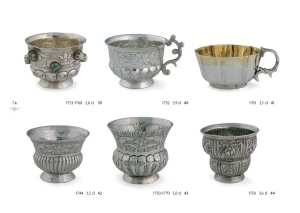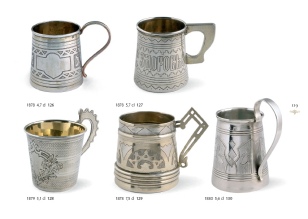|
|
CHARKA
Charka is a drinking vessel used in Russia. The word charka means vodka or tot cup which has a
centuries old tradition in the Russian culture.
As well as a liquor cup, a charka is also an old vodka measure of 143,5 ml, first appearing in the 16th
century. As a result of the 19th century decree, the measure was reduced to 1/100 vedro, which corresponds
to 123 ml.
Charka has been an object of vertu which has been carefully designed. The charkas have changed their form
during the years and each reign and period has given them its typical shape. You can see the features
from the mid 17th century renaissance to baroque, rococoo, different stages of classism and the late 19th
century panslavonic design.
The early 17th century charkas were usually large and shallow. At that time, vodka was weak, only 15-20%.
When the art of distilling developed, vodka became stronger and the charkas became smaller.
|

The late 17th century charkas can be divided into several distinct variations. Common features found in
all types of charkas are the flat horizontal handle and either one or three feet. The earliest models,
seemingly from the third quarter, were usually unmarked cups, often demi-spherical or shallow in shape.
Perhaps the most common charka of this time is comprised of a cup with one foot and a horizontal handle. It
is adorned with sea monsters and large birds, a popular motive being Jonah and the whale.
Only a limited number of charkas are available from the first quarter of the 18th century. The style
changed at the turn of the century and the charkas started to resemble traditional goblets. The most common
shape of the 18th century was one of a thistle flower often with a scroll handle attached to it in a
vertical position.
From the early 19th century, glass replaced silver as the material of drinking vessels. Thus there are few
charkas on the market from this period. Also the style changed and the 18th century designs were no longer
appearing on the market. Later in the 19th century rich panslavonic design became dominant.
At turn of the 20th century silversmith profession reached a new level with several suppliers to the court
like Faberge, Grachev, Khlebnikov, Occhinnikov, Sazikov among others.
The text and the images of this page are property and copyright of Kari Helenius.
You can learn more from a recently published book:
The Russian Charka. The Silver Vodka Cup of the Romanov Era
The K Helenius collection of charkas of the Romanov era 1613 – 1917
157 charkas arranged by the period, 204 pages, 255 pictures,
text in three languages; English, Russian and Finnish
Size 170mm (height) x 230 mm x 20mm. Hard cover
Publisher W Hagelstam, Helsinki 2006, ISBN 952-5125-23-8
Price € 49,90 (1st class mail included)
If you are interested in the book please send email to Kari Helenius,
email: er1343@kolumbus.fi
|
 |

|

www.silvercollection.eu |
This is a page of 'The What is? Silver Dictionary' of A Small Collection of
Antique Silver and Objects of vertu,
a 1000 pages richly illustrated website offering all you need to know about
antique silver, sterling silver, silverplate, sheffield plate, electroplate silver,
silverware, flatware, tea services and tea complements, marks and hallmarks, articles,
books, auction catalogs, famous silversmiths (Tiffany, Gorham, Jensen, Elkington),
history, oddities ...
SITE MAP - SILVER DICTIONARY |
| |